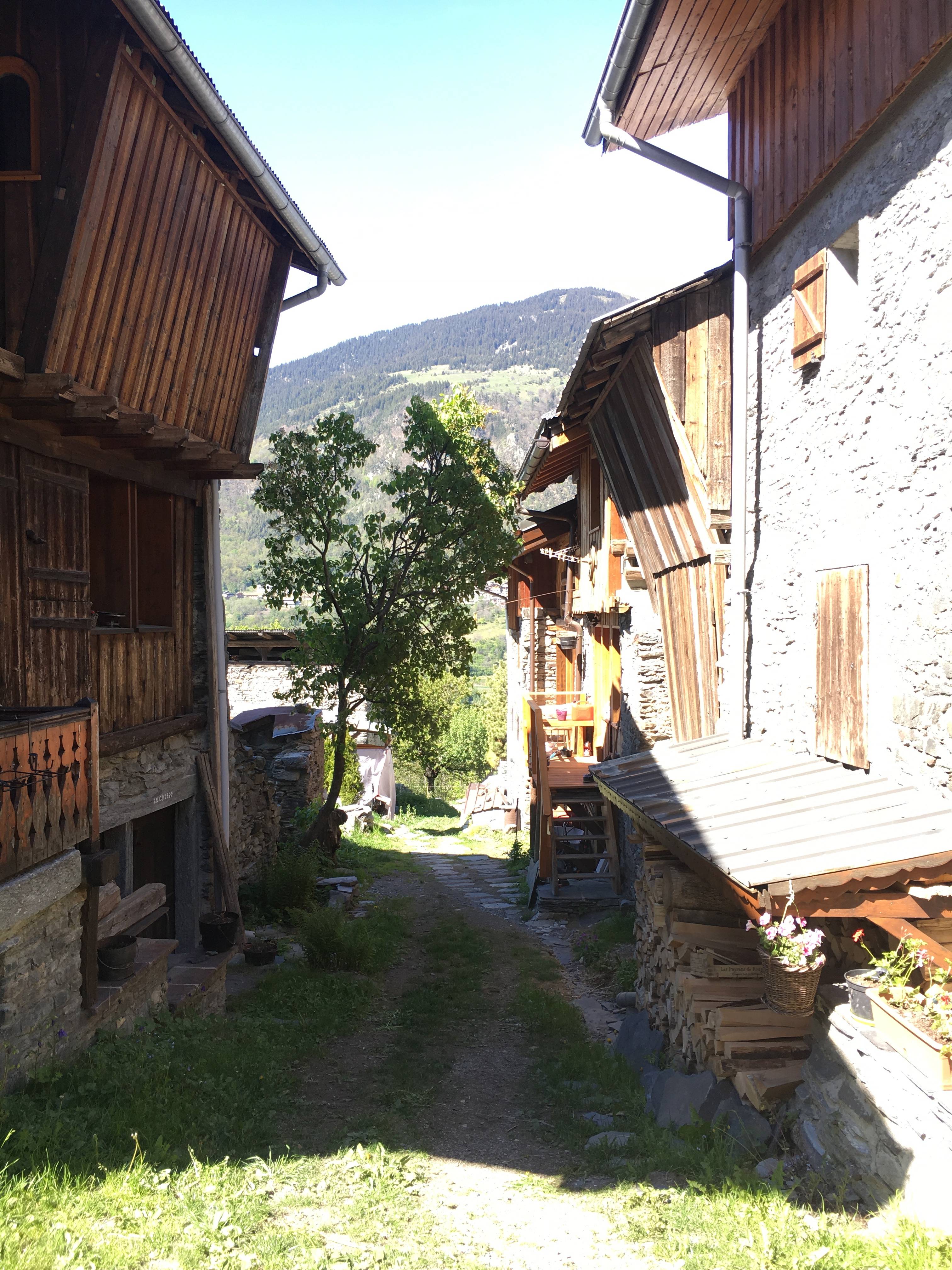
7-Getting acquainted with La Source's heritage in the hamlet of Villarnard
Woodland trail : 8 km
Description
Take care when crossing the départementalroad on your way up and down.
Follow the green waymarks: Rando de la Source.
E-bike rental shop:
Sport 2000 Happy Mountain
39, rue Aristide Briand
73570 BRIDES LES BAINS
+33 (0)4 79 08 72 17
- Departure : Brides Les Bains Town Hall Place de l'Église 73570 Brides-les-Bains
- Arrival : Brides Les Bains Town Hall Place de l'Église 73570 Brides-les-Bains
- Towns crossed : BRIDES-LES-BAINS and LA PERRIERE
Forecast
Altimetric profile
Recommandations
If in doubt, you can take an introductory lesson in how to ride an electric bike with an instructor.
If you see a herd ahead, slow down and go round it. If there is a patou, a guard dog, climb down from your bike and walk, pushing it alongside you. Avoid making any sudden or aggressive gestures towards the dog and move away from the herd slowly and calmly. The dog will only be checking that you do not pose a threat to its herd. Respect the parkland and close gates behind you after you've gone through them.
The mountain is living, please respect it by staying on the paths and tracks.
Information desks
Place du Centenaire, 73572 Brides-les-Bains
Transport
Then coach transport to Brides-Les-Bains.
Information:www.transavoie.com
Also consider carpooling.
Access and parking
Parking :
Accessibility
- Emergency number :
- 114
8 points of interest

Village de Brides-Les-Bains - CCVV  History
HistoryVillage of Brides-les-Bains
The village is a spa resort that is busy in winter and summer alike. Located at the foot of the world’s largest ski area, it’s the ideal base camp for participating in a whole host of winter and summer activities, including boardsports, toboggan runs, hikes and rambles, rafting and cycling.
Brides-les-Bains is famous as a spa resort, the nation’s top resort specialising in slimming and rheumatism. In addition to the benefits of its cures, Brides-les-Bains is a genuine wellbeing destination ensuring you enjoy true relaxation and really get away from it all!
Following an energetic outing on your e-bike, why not treat yourself to a relaxing break at the Grand Spa Thermal, the biggest spa in the Alps: 2,700 m² and including aquatic and relaxation areas... it would be a real shame to miss out on it! Not forgetting that there are other spas that will also give you a warm welcome.
And there’s no lack of activities and entertainment to enjoy, including the Angoulême Film Festival in Brides, the “Ça Jazz à Brides” festival and plenty of other events focusing on music, cookery, culture and local traditions. Brides even boasts its own casino.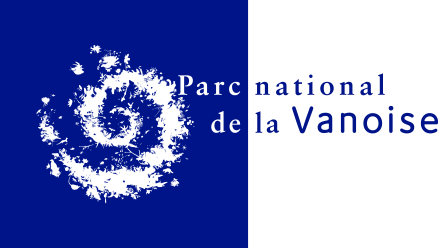
 Know-how
Know-howE-bike rental: Sport 2000 Happy Mountain
Sport 2000 Happy Mountain
39, rue Aristide Briand
73570 BRIDES LES BAINS
+33 (0)4 79 08 72 17
 Small heritage
Small heritageThe covered washhouse of Villarnard
It is equipped with a remarkable pair of 4-metre-long dressed stone slabs and is located at some distance from the hamlet.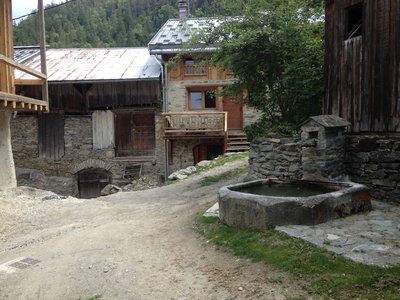
Le hameau de Villarnard - D. Dereani  History
HistoryHamlet of Villarnard
Located in the delegated municipality of La Perrière, which has been part of the municipality of Courchevel since 2017, the hamlet lies on the northern slope 1000 metres above sea level, surrounded by a variety of landscapes. Huddled in the midst of a plateau, its vernacular architecture bears witness to the art of “traditional building”. The hamlet has largely succeeded in protecting itself from the ravages of poorly conceived renovations; many of its buildings are still in their original state, coming into view as you turn down an alleyway, their walls free of bituminous cladding.
The village has kept all its heritage features intact, witnesses to the community life of days gone by: its Saint Roch and Saint Bernard Chapel, bread oven, covered washhouse, bachals (communal water troughs) and former school, which now houses the Maison du Patrimoine (Heritage Centre). The hamlet’s name derives from the word “Villard” or “Villaret”, which originally meant a small property, detached from a larger one in the 5th century, and the name of its first owner. In bygone days, Saint Roch, one of the hamlet’s protectors, was invoked against epidemics, the black death in particular. His feast day falls on 16 August.
The former school, which fell out of use in the 1950s, was renovated by members of the “Le Patrimoine de Villarnard” (Villarnard’s Heritage) Association. It has become the Maison du Patrimoine and houses a museum that acquaints you with men’s and women’s lives and professions and their children’s schooldays in a mountain environment. The museum is documented by a wide range of works complied and published by the Association’s members and bearing witness to life in times past; it even exhibits a selection of the tools employed in bygone days. If you’d like to learn more on the subject, the works in question are available for sale.
The Heritage Museum is opened periodically by members of the association during July and August, and on Heritage Days.
Unaccompanied visits.
Admission free.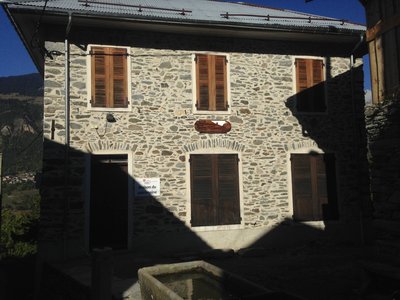
Ancienne école de Villarnard devenue la Maison du Patrimoine - D. Dereani  Small heritage
Small heritageThe hamlet’s former school
Typical of late 19th-century architecture, the building is topped by a hipped roof and boasts a sturdy pegged wooden framework testifying to the fine reputation of La Perrière’s carpenters. Its painted trompe-l’oeil corner decorations are still intact.
Until 1952, the school had a classroom that could accommodate up to 35 pupils. It was an itinerant facility as the hamlet’s inhabitants moved house according to season. From the hamlet below to the one in the middle, and then higher up to Villarnard, and then down again following the same pattern in reverse.
The schoolmistress started the school year on the 1 October, closing the school two weeks later when the children’s families had to make their way down to Champétel for the harvesting and apple-picking season, emptying Villarnard of its population. She then opened up Vignotan’s school. With the coming of winter, all the families made their way back up to Villarnard as the hamlet’s barns stored the hay used to feed their cattle.
They stayed there until spring, when then the schoolmistress again closed the school so as to enable the families to go and work in the valley’s fields and plant their crops before returning to Villarnard later with their livestock. Although it was an itinerant school, the mistress always taught the same pupils. In the summer, as she had rather fewer pupils in her class every day, she packed her knapsack with books and went up to the pastures of Le Bouc Blanc with the animals. So it was that she followed her pupils as their families moved from one spot to another, and, high up in the mountains, taught them the names of their peaks and read them stories.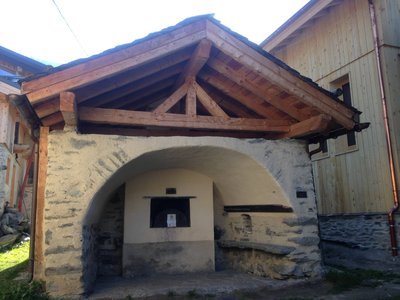
Le four à pain de Villarnard - D. Dereani  Small heritage
Small heritageThe bread oven of Villarnard
In bygone days, this was a major centre of social life where the population gathered periodically to bake enough bread to last them several weeks. It was renovated throughout in 2006 thanks to the combined action of the Le Patrimoine association and Savoie’s Architecture, Urban Planning and Environmental Council (CAUE).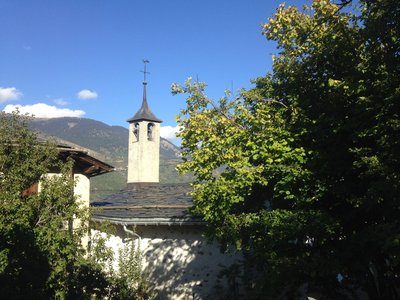
La chapelle St-Roch et St-Bernard - D. Dereani  Small heritage
Small heritageSaint Roch and Saint Bernard Chapel
It was built in the 16th century and still contains its original walnut communion rail and collection chest, along with a recently restored painting of agrarian saints.
L'un des bachals de Villarnard - D. Dereani  History
HistoryThe “bachals”
These are stone water troughs that once provided the inhabitants and their livestock with drinking water. One of the hamlet’s bachals is a truly remarkable piece of work, hewn out of a single huge piece of solid rock.
